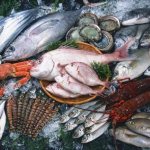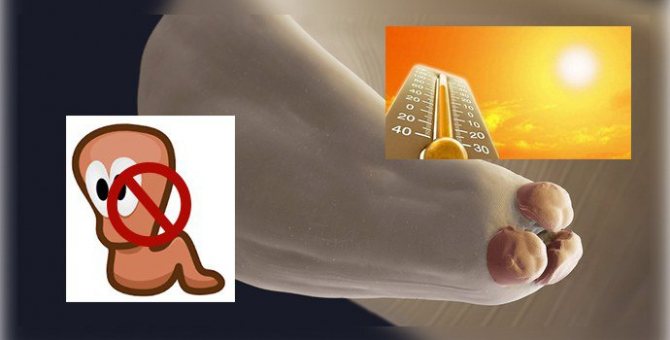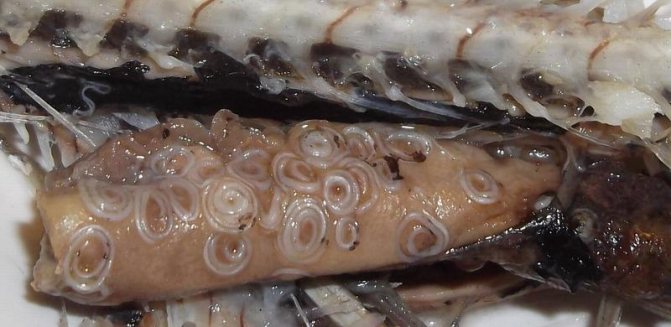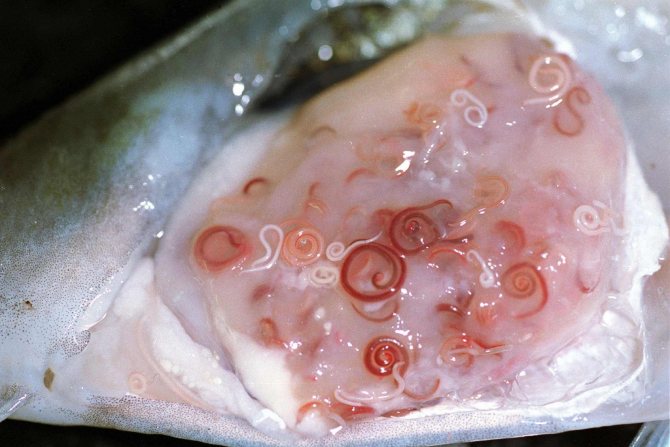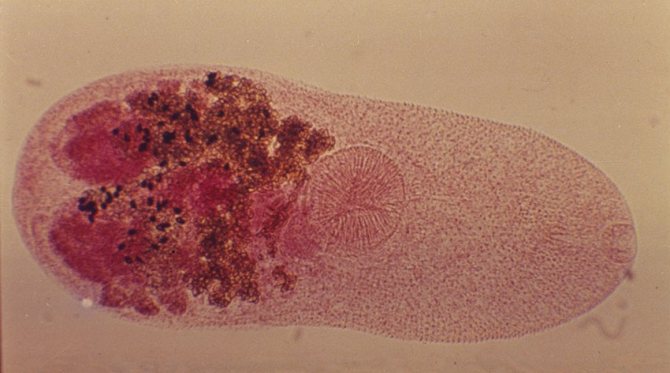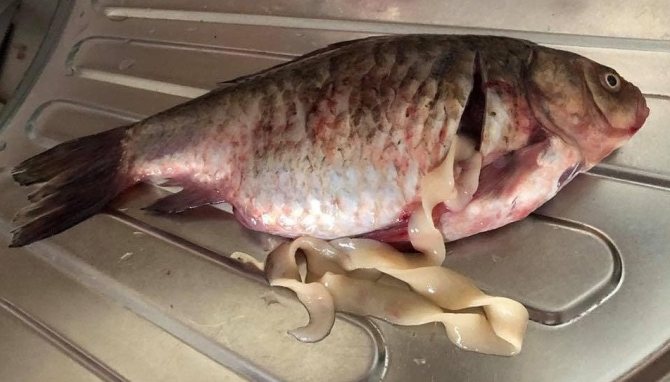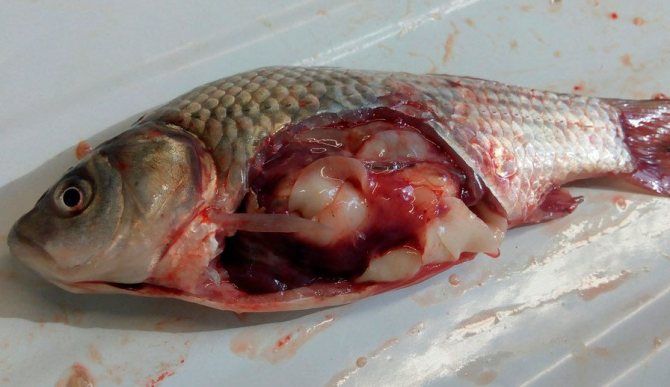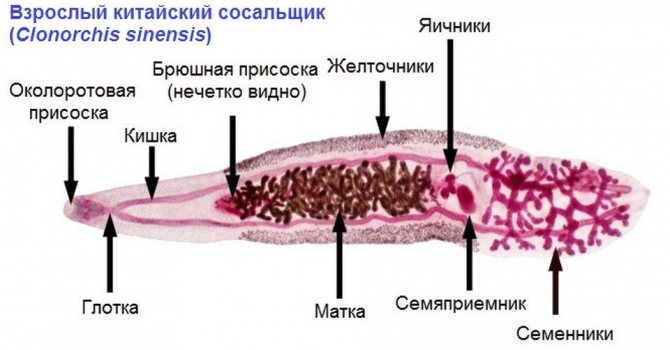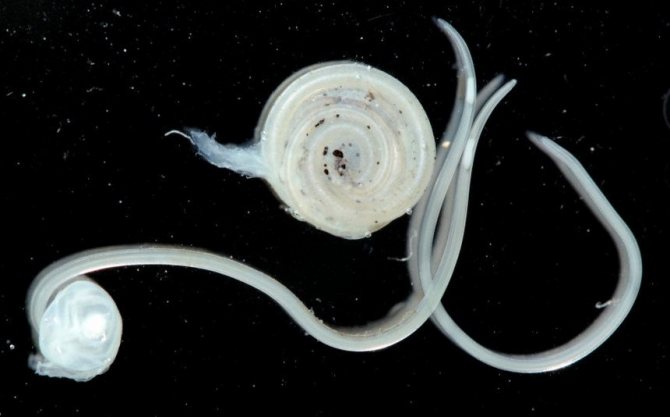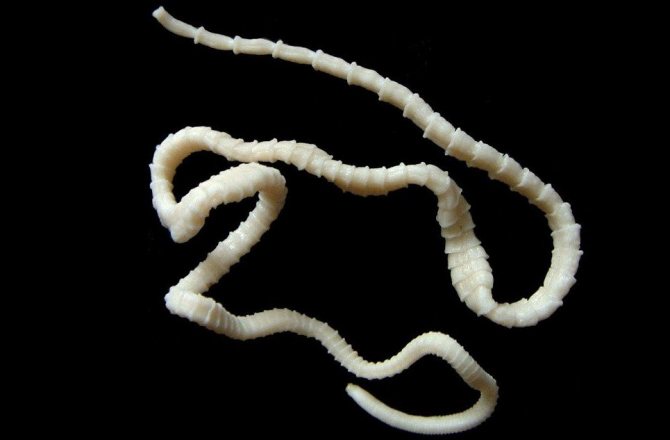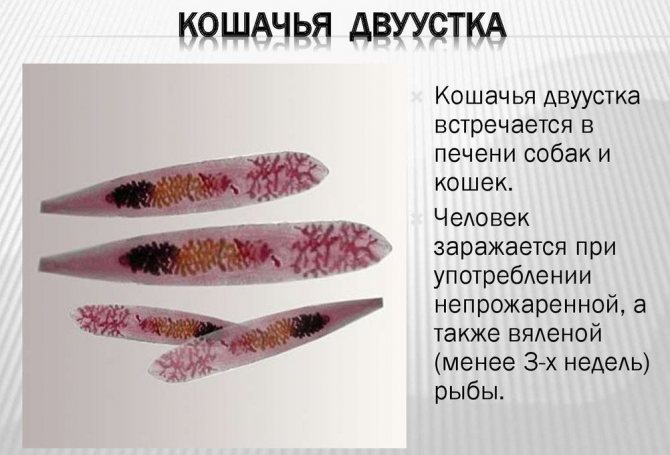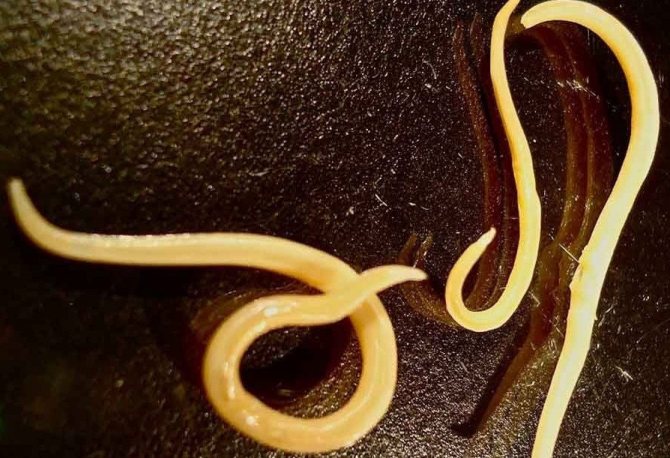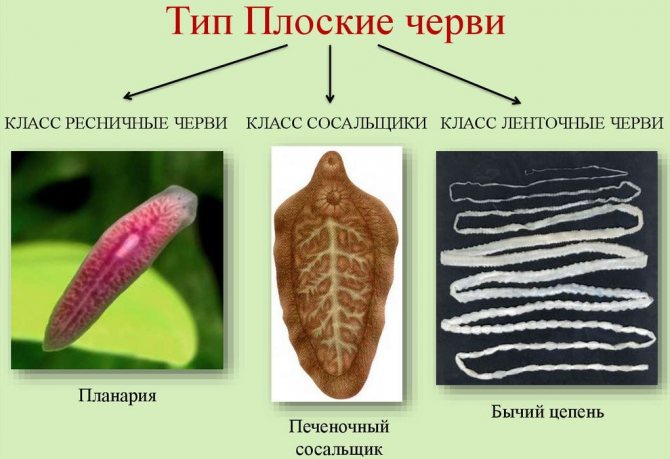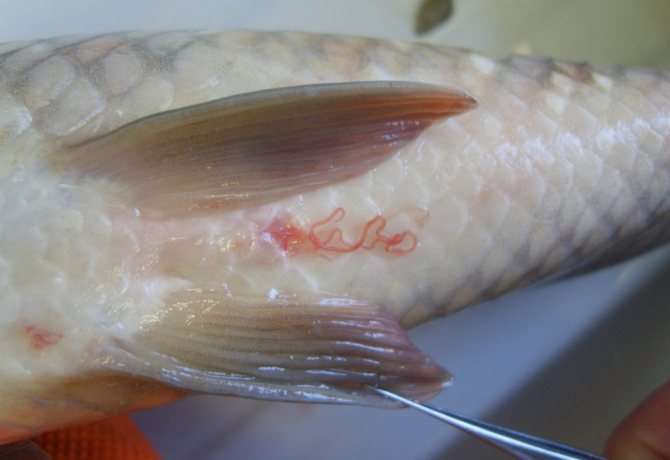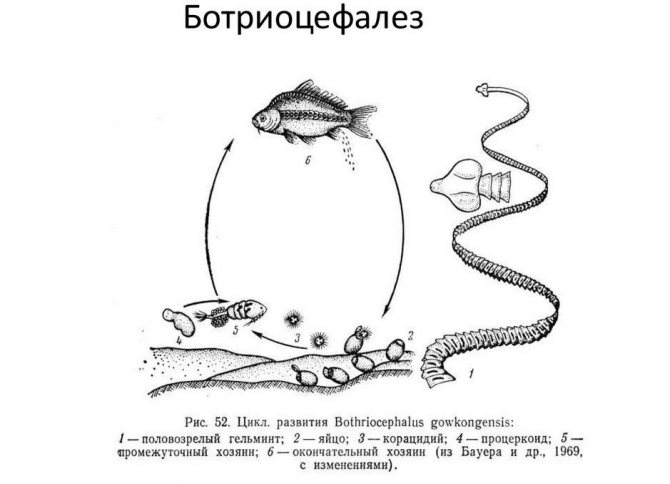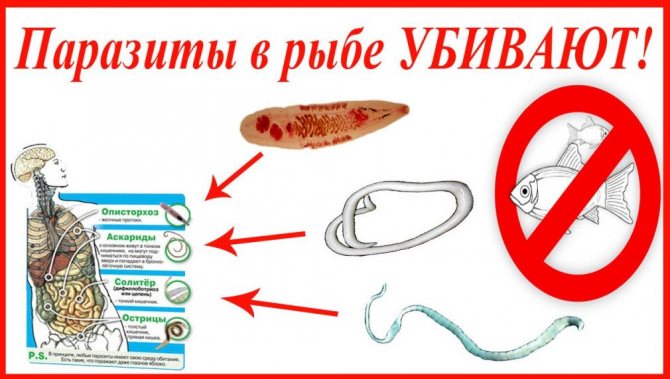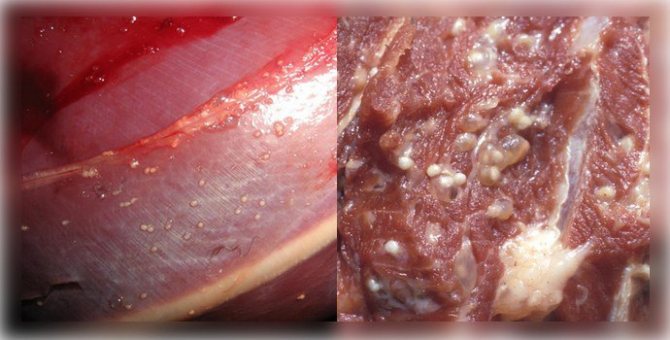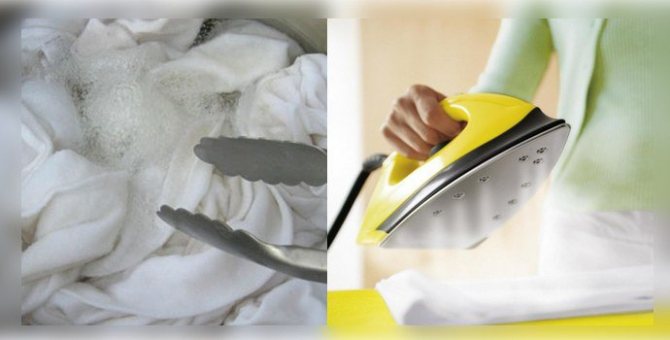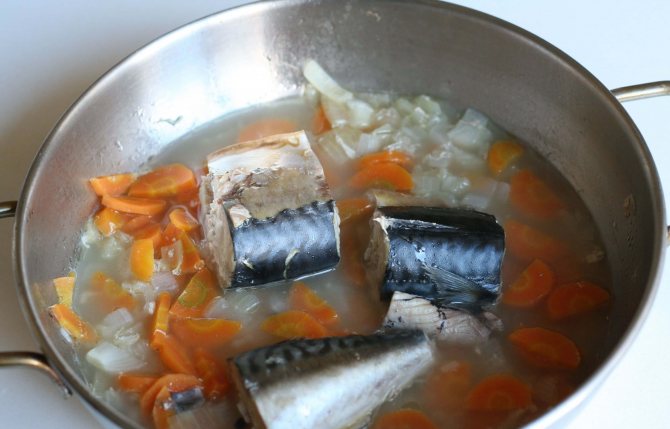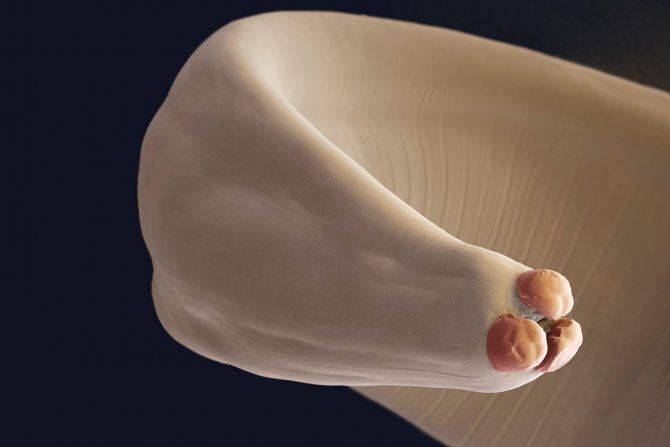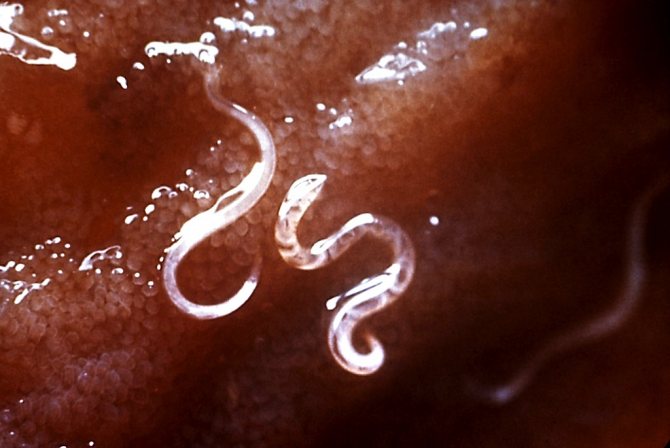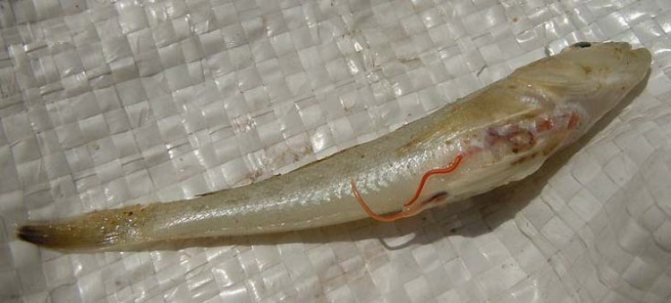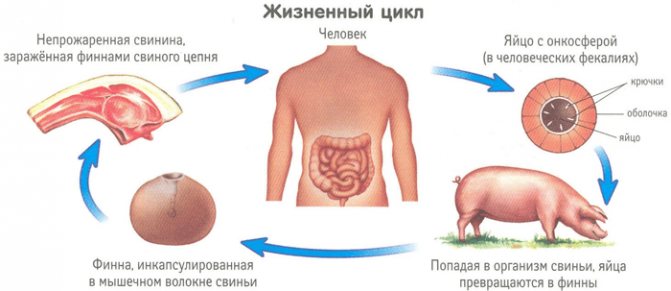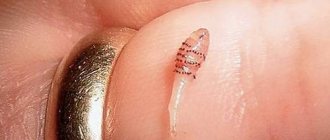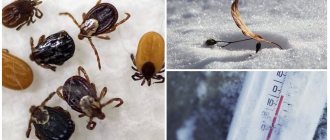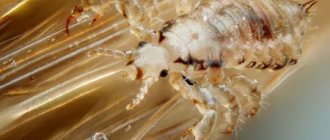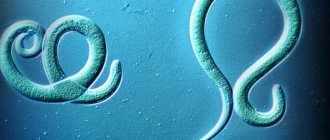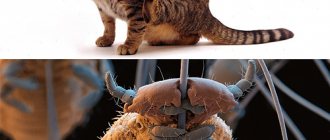Types of worms found in aquatic inhabitants
Are there parasitic microorganisms in the body of aquatic inhabitants? River fish are more likely to become infected with helminths than from marine species. There are also diseases that are dangerous to humans that can be contracted from fish.
Opisthorchiasis. The disease is triggered by the feline fluke. Fish are only intermediate hosts. Dogs and cats are considered carriers. The size of the worm reaches 12 mm, it parasitizes in the liver, gallbladder, pancreas. They can exist in carp breeds.
If you eat fish infected with feline fluke, the first symptoms will appear only after 2-3 weeks. The main signs are fatigue, pain in the head, muscles, joints. The respiratory system is affected. There is a cough, shortness of breath. The digestive organs are enlarged, the liver and spleen are especially affected. Disturbed by the rash and itching of the body. Body temperature can rise to 39-40 degrees.
The acute phase lasts only a few days and then turns into a chronic latent stage, slowly destroying all internal organs of a person. When the first signs appear, you need to contact a specialist.
Diphyllobothriasis. The disease is caused by a wide tapeworm, which can reach 12 meters in length. The main carriers of parasites are: river fish, salmon breed, perch, pike.
Clonorchiasis. The causative agent is a Chinese fluke. Most often it can be in the body of minnows, crucians, carp. Only after 2-4 weeks, the first symptoms appear in the form of high fever, muscle pain, skin rashes. The liver is enlarged, the upper right part of the abdomen hurts. Disturbed by the increased formation of gases, flatulence. Vomiting and diarrhea join.
Metagonimosis. The causative agents are trematodes only 2.5 mm long. A week after the larvae enter the digestive organs of a person, a rash appears on the body, appetite is disturbed, body weight decreases, vomiting, diarrhea, pain in the central part of the abdomen join.
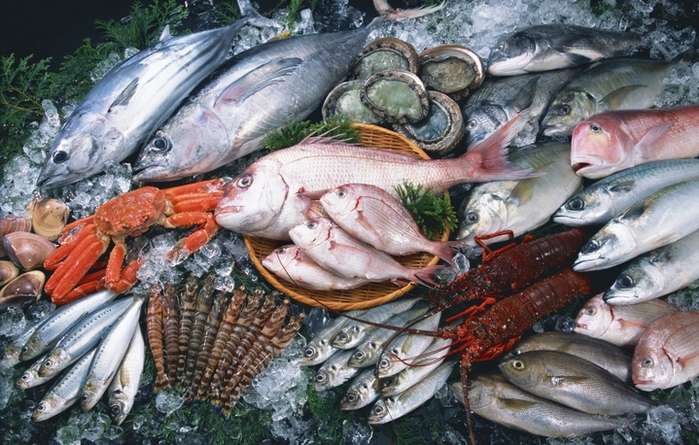
Anisakidosis. Such helminths in fish, such as anisakids, parasitize in the intestines. Mostly found in marine fish. You can get infected by eating a slightly salted product, in particular herring. After a few hours or days, pain in the head begins to bother, the body temperature can rise to 38 degrees. The patient is worried about nausea, which then turns into vomiting, abdominal pains appear, and there is no appetite. An allergic rash all over the body is a common symptom.
Ligulosis. The disease is caused by a tapeworm - an ordinary beltworm. It can be up to one meter in length. It causes diseases of all internal organs. Dizziness, headaches appear, body temperature rises, vomiting and diarrhea worries.
Dioctophimosis. Helminths are localized in the organs of the urinary system and disrupt its work. Weakness, vomiting, diarrhea appear, the digestive organs increase, the bladder becomes inflamed, and pyelonephritis develops.


Nanofietosis. The disease is caused by small fluke worms. Adults live in the small intestine. Disturbed by pain in the lower abdomen, diarrhea, flatulence.
How to protect yourself from parasite infestation
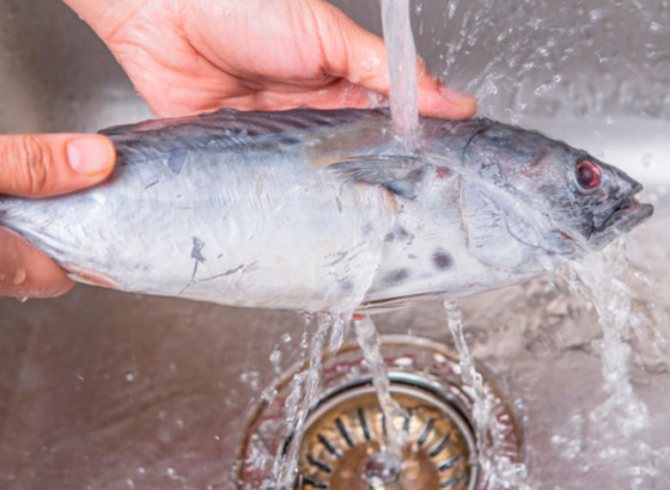

Knowing that fish can contain various parasites, you should adhere to the cooking technology, subjecting the fish to heat treatment. These technologies include:
- Cooking.
- Frying.
- Hot smoking.
- Deep ambassador.
- Deep freeze.
If the fish is cooked for at least 20 minutes, then any types of parasites will die in it. If the fish is fried, then this is another quite effective way to get rid of parasites, since the temperature regime is higher than during cooking. Hot smoking also allows you to neutralize parasites, but the duration of processing should not be less than 2 hours.
In addition to temperature treatment, there are two more options that make it possible to protect a person from infection with helminths - these are deep salting and deep freezing. Salt destroys all types of parasites within 2 weeks. If large fish is used for salting, then the processing terms should be increased.
You can also destroy parasites by deep freezing, at a temperature of -40 degrees. In such conditions, the parasites die within 24 hours. Before such a technological procedure, the fish is thoroughly washed under running water.
As you can see, there are enough ways to disinfect fish, so it is not problematic to use any of them.
Recently, it has become fashionable to eat fish without proper heat treatment, since most of the beneficial components, such as minerals and vitamins, are retained in such dishes. But then you need to be 100 percent sure that the fish meat does not contain parasites, otherwise healthy food will turn into serious health problems over time.
Tips from an experienced ichthyologist
The most frequent "guests" are tubular small red worms in fish, up to 5 cm in length. They can be found in perch, goby and pike perch. It is quite possible to eat fish infected with them, having previously cleaned its meat from parasites.
We suggest you familiarize yourself with: Subcutaneous mite - an imperceptible neighborhood
According to the candidate of biological sciences Roman Novitsky, an experienced ichthyologist, such fish must be thoroughly cleaned and properly cooked. If you fry it, then this should be done for at least 10 minutes so that the helminths come out, and if you decide to make salting, then keep the fish carcass in a salt solution - for at least two days. According to him, when frozen, these parasites do not die and after thawing they become quite viable.
Novitsky also advises to pay attention to herring, which at the moment, according to statistics, is infected with helminths by 60%. The cleanest fish, according to the ichthyologist, are catfish, mackerel and tuna, which live in the open sea.
But here, too, the presence of parasites was not without. It's just that there are not so many of them in comparison with other types of fish, and they are not striking. For this reason, carefully process all fish that are intended for your food, just in case.
Worms in sea fish
A high probability of infection with helminthiasis exists when eating dishes prepared from worm-affected marine fish that have not undergone the necessary processing.
Tapeworms in pollock and sea bass
Alaska pollock is one of the most accessible fish for the majority of the population. At the same time, it is in first place in terms of the degree of infection with parasites. The popular sea bass is no less dangerous. Tapeworms are a common type of helminth that infects these fish species. Having carefully examined the insides of the fish during cutting, they can be detected even with the naked eye.
What do worms look like in pollock
Helminths and their larvae in pollock are located on the inner surface of the abdominal cavity, viscera, and muscles. Among them are found:
- Cestodes are tapeworms most commonly found when cutting infected fish due to their size. The largest representative of this class is the broad tapeworm, an adult of which can reach a length of 10 m.
- Trematodes are flatworms that are almost impossible to detect visually.
- Siberian fluke is a miniature parasite no more than 12 mm in size. It resembles an outwardly elongated translucent leaf.
- Chinese fluke. Differs in larger sizes - up to 25 mm.
Even having an idea of what worms look like in fish, it is far from always possible to detect them visually. The presence of many types of helminths is detected only with the help of laboratory tests.
Diphyllobothriasis
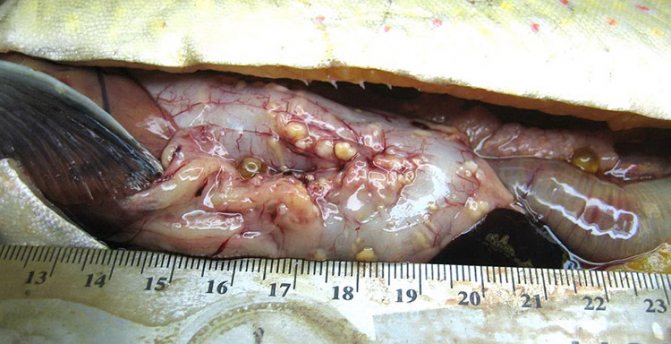

One of the most common types of helminthiasis, the causative agent of which is the broad tapeworm, as well as other, less studied tapeworms. A person, when eating infected fish, becomes the final host of the parasite. The disease has no specific symptoms, therefore, it is often detected when pieces of a worm are noticed in the feces. The organs of the digestive tract are mainly affected. The patient experiences periodic abdominal pain, weakness. Stool disorder, vomiting, lack of appetite, and a change in taste are often observed. Sometimes there are allergic rashes in the form of urticaria.
Roundworms in herring, cod and pink salmon
Even fish, which is considered a delicacy, does not guarantee the absence of helminths in it. Poorly processed salmon, pink salmon, chum salmon, causes serious pathological processes in the body. Nematodes (roundworms) enter the human intestine in the stage of yellowish larvae. Worms in red fish can be up to a thousand individuals. Most of all, lovers of raw or slightly salted fish, sushi, rolls are at risk of infection. Cod, beloved by many, is often affected by microscopic crustaceans, which, when decomposed, cause purulent processes.
What do worms look like in herring
Parasites in fish are eliminated by exposure to high temperatures. However, the herring is sold ready-to-eat and is not subject to heat treatment. As a result, the risk of infection with helminthiasis is quite high. Due to being in a saline solution, worms and larvae acquire resistance to an aggressive environment. Once in the human digestive system, they multiply successfully. The most common worms in salted fish are:
- Cat fluke. A parasite with an elongated flat body about 3 cm in size, the causative agent of opisthorchiasis.
- Wide ribbon. A tapeworm that causes diphyllobothriasis.
- Anisakids. The worms are spindle-shaped, reaching lengths of up to 6 cm. There are three lips at one of its ends.
The larvae of the latter are the most dangerous. They are capable of causing anisacidosis, a serious illness accompanied by severe complications.
Anisakidosis
The larvae of the parasite are localized inside the organs of the gastrointestinal tract, which leads to damage to the mucous membrane with characteristic symptoms:
- Nausea, vomiting.
- Stool disorders.
- Flatulence.
- Pain in the iliac region.
- Allergic rashes.
In some cases, anisacidosis is accompanied by fever, cough, sore throat caused by the throwing of bile into the esophagus. Lack of timely treatment threatens intestinal obstruction and peritonitis. Being in the human body from 3 weeks to 3 months, helminth larvae cause irreparable damage to human health. Knowing about the consequences of anisakidosis, the question of whether it is harmful to eat herring with worms is no longer worth it.
Activities that are carried out with a therapeutic purpose
In case of confirmation of the diagnosis, which indicates the presence of parasites in the human body, it is imperative to carry out treatment. The selection of the drug and its dosage is carried out by the doctor in each case individually.
Tapeworm treatment should only be done in an inpatient setting. The drug is taken in stages, while at the same time the appointment of drugs that protect the liver is carried out. Most often, German-made drugs are prescribed, although Russian drugs are no exception. Anthelmintic drugs kill the parasite and remove it from the body cavity. But sometimes tapeworm leads to the formation of intestinal obstruction - in this case, the treatment must be surgical.
As for such a disease as opisthorchiasis, it is quite difficult not only to treat it, but also to diagnose it. These parasites of fish can inhabit the human body for many years without showing themselves in any way. The most effective drugs for the treatment of this pathological condition:
- Eksol;
- Populin;
- Biltracid.
Clonorchiasis is currently detected at any stage of its existence. Despite this, getting rid of it is not easy. In addition to anthelmintic drugs, they are additionally prescribed:
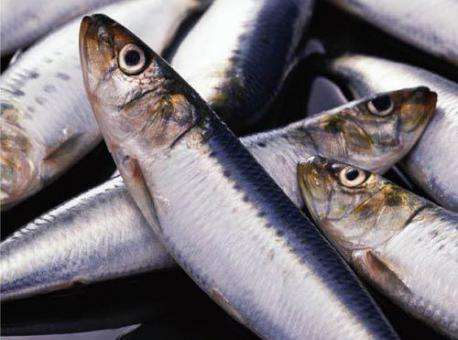

- anti-inflammatory drugs;
- antiallergic;
- antispasmodics;
- agents that promote the excretion of bile;
- sorbents.
A disease such as metagonimiasis is treated with the following drugs:
- Biltricide;
- Cesol;
- Cysticide.
Nanofietosis is treated with Biltricide or similar drugs. In parallel, they recommend dietary food, table number 5, drugs that promote the excretion of bile, and antispasmodics. Additionally, a remedy should be prescribed, the action of which is aimed at protecting the liver.
For a long time, such a disease as anisacidosis did not pose a danger due to the fact that these fish parasites did not have the ability to develop and reproduce in the human body. But over time, the larvae of parasites have learned to inflict considerable harm on the body. The consequences of their presence can lead to the need for surgical intervention.
If the case is not difficult, for treatment it is enough to drink drugs such as Mebendazole and Albendazole.
What fish does not have opisthorchiasis
The question of which fish does not contain worms and parasites has an ambiguous answer. This is due to the fact that absolutely all groups of individuals are susceptible to the emergence of "uninvited guests", and only artificially grown food products do not have parasites, since they are injected with special remedies for helminths to prevent their occurrence.
For freshwater, marine and oceanic fish, all species are susceptible to contamination. It is impossible to say what kind of fish is without parasites, but species and families can be noted that are least susceptible to the action of the disease.
Fish living in the open sea or ocean, as well as those that swim in cold water, are least susceptible to the action of these microorganisms, since under these conditions an unfavorable habitat is formed for helminths, and it is problematic for them to get into such distant zones.
The main types of such individuals include several fish:
If we consider species that are moderately susceptible to the occurrence of helminths, several pieces can be distinguished:
Most often, helminths are found in the following fish species:
Therefore, opisthorchiasis - which fish does not have this disease - the question is ambiguous.
By taking all preventive measures before eating fish and fish dishes, you can protect yourself from dangerous infection with helminths and get excellent good health in return for a long time.
Parasites in fish are dangerous organisms that can severely compromise human health. According to statistics, 75% of the total world catch contains eggs of parasites, it is often impossible to see them with unarmed gas and it is possible to determine that the fish is infected only with the help of a microscope.Nevertheless, fish is a very valuable and useful product for the human body, therefore, you should not refuse to eat it, especially since not all helminths in fish are dangerous for people. In addition, with proper preparation, you can protect yourself and your loved ones from negative consequences.
It is important to know fish worms - how they look (if it is possible to make out them), at what temperature parasites die in fish, how to properly prepare a product in order to prevent pests from entering the human body
Is it possible to neutralize fish from parasites?
For fear of contracting helminths, some people even completely abandon this tasty product. And in vain! Potential parasites can be killed and thus made the fish safe for humans! This is possible in several ways:
Freezing. Scientific studies have proven that parasites in fish are killed when frozen
The temperature factor, uniformity and duration of freezing are of great importance. The speed of freezing after catch and the time it takes for the fish to thaw are also important.
The so-called shock freezing of -40 ° C leads to the death of opisthorchis
Pay attention to the size of the fish. The larger the individuals, the longer the freeze should be.
If you place fish weighing up to 2 kg for 12 hours in temperature conditions not lower than - 27 ° C, thus, you can destroy other types of parasites.
In the north of Russia, stroganin is often used. But it does not correspond to the above cooking recommendations. The exception is sterlet, in which helminths are very rarely found.
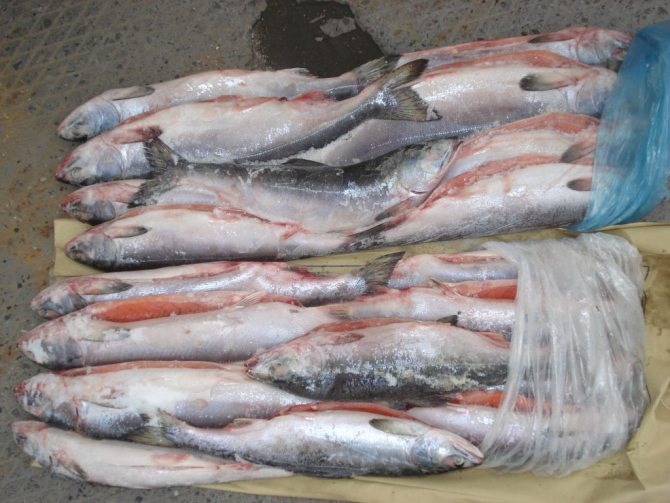

Salting, smoking, drying. Wherever fish are caught, these cooking methods are common. Salt and smoke treatments have long been used to kill parasites in fish. At least that's always been the case. But science has taken up the study of this issue only recently. What has the research led to? It turned out that hot smoking can kill almost all types of parasites in fish fillets. Cold smoking, however, is not as reliable.
Hot salting (15-16 degrees) leads to the death of parasites after 9 days. Cold salting (5-6 degrees) ensures the death of larvae after 13 days. Dry salting (20% salt by weight of fish) leads to the destruction of larvae in salted whole fish after 13 days, and in cut fish after 7-12 days.
Cooking, frying, baking. They are considered the most reliable processing methods, but only if the fillet is cut into pieces. Fish fillet boiled after boiling for 30 minutes can be considered absolutely safe. It is recommended to cover the pan with a lid during frying. This provides better quality disinfection. Baking is also desirable for 30 minutes, at least at a temperature of about 200 ° C. Cutting fish should be done at home with a special knife dedicated to working with it. It is also advisable to have separate dishes for fish dishes.
If you love baking fish tarts, keep them in the oven for at least 30 minutes. Remember that only certain types of sturgeon and fish raised in artificial conditions can be consumed raw.
But what if you have already eaten fish with parasites?
If you come to such conclusions, don't panic! If the fish fillet has been frozen or thermally processed, then there is no cause for concern. When it comes to raw fish cooked against the recommendations, it is necessary to start preventive measures as early as possible. You should consult a doctor in order to undergo a diagnosis and establish which type of parasite has entered your body.
Do not hope for a miracle, since some parasitic worms lead to irreversible dysfunctions of internal organs. This situation can be corrected at the initial stages with conventional anthelmintic agents. But only a doctor should prescribe them.He will be able to find the ideal dosage according to your age and body weight. Uncontrolled use of such drugs can lead to ineffective treatment.
But even after you have drunk the drug, you need to re-take the tests (about a month later). This is necessary to be sure of the positive effect of the medicine.
Can parasitic fish be cooked and eaten? There is an opinion that shrimp and squid are supposedly safe for humans, since they are not susceptible to helminthiasis. But it is not so. Helminths in squid are not so rare. They are usually attacked by nematodes. If you find parasites in squid, do not rush to throw them away. It is necessary to thoroughly clean the fillets from parasites, and then thermally process them.
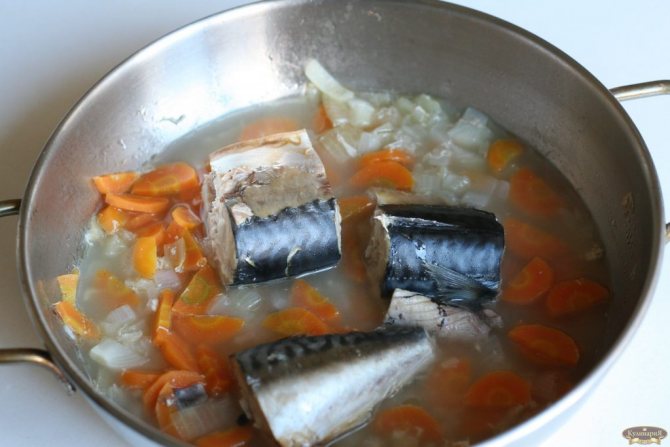

What to do with infected fish? It all depends on the specific type of fish and how it is prepared. Fish parasites die at temperatures below 25 degrees and above 100 degrees. So what exactly do you do to safely eat contaminated fish?
If you are going to cook fish, keep it in boiling water for at least 30 minutes.
The fish must be fried for at least 20 minutes. If it is large, you can cut it into portions and cook afterwards.
Sick fish must be thoroughly washed under running water before cooking, remove all entrails and subject to heat treatment.
The impact of negative temperatures on helminths
As noted by researchers in the field of medicine, worms in fish and meat can be killed by freezing infected foods for at least three hours.
After that, the food becomes safe for humans. Meanwhile, in order for the parasites to really die, it is necessary not only to cool the meat or fish, but also to create a certain low-temperature regime.
Scientists parasitologists have proven that worms and larvae die only if the freezing took place for a long period of time at a temperature of no more than -40 degrees.
If food is frozen at a temperature of -25 degrees, the death of parasites is possible only after 72 hours. Thus, in order to make fish and meat a safe product, they must be kept in a freezer using a low-temperature regime.
Views
Doctors say that parasites can indeed be found in fish. So the hostess can meet the worm in mackerel, cod, horse mackerel and many other varieties. Moreover, worms can be found in fish not only in fresh products, but also in salted and smoked ones. Are there worms in seafood? Yes, worms can be classified into 2 types:
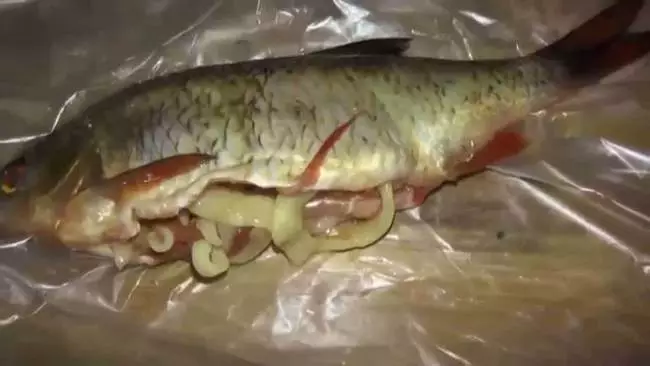

- There are safe helminths.
- Dangerous.
By giving preference to fish, you can earn a disease that harms not only health, but can also lead to death.
Doctors identify several types of parasites that can be found in the products of the seas:
- Roundworms.
- Suckers.
- Tape parasites.
If the fish has not undergone sufficient heat treatment, then a person becomes infected with worms, since the fish is exclusively a carrier, and a person is considered the owner, where the worm can grow and develop. Let's consider the most common diseases caused by fish with worms. Consider the parasites in marine fish that are dangerous to humans:
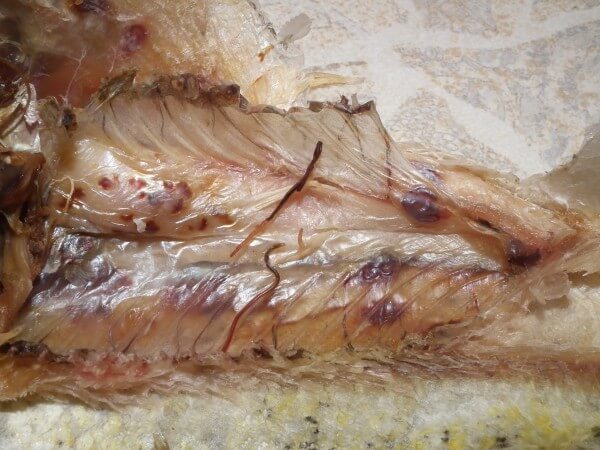

- Opisthorchiasis or a disease caused by a feline fluke. Varieties of fish with worms are exclusively the carrier of the invasion, and humans are the host. Pets are considered the carrier of this pathology. The size of the worm is no more than 13 mm, it grows and develops in the liver, gall bladder, pancreas. They can also be found in carp fish. If a person ate contaminated fish, the first clinical picture appears after 20-21 days. The main clinical manifestations: fatigue, migraine, pain in muscles and joints. A person's respiratory system is affected, while a cough appears, breathing is difficult. The spleen and liver are affected.A person has allergic reactions throughout the body. Temperatures can rise up to 40 degrees Celsius. The acute period of pathology lasts a couple of days, then the disease proceeds in a chronic form.
- Diphyllobothriasis or pathology caused by a broad tapeworm. This parasite can reach up to 10-12 cm. The main vectors are river fish: perch, pike and salmon. The incubation, asymptomatic period lasts up to 60 days and only after that the first clinical manifestations appear. At the same time, high body temperature, fatigue, rapid fatigue are noted, appetite is disturbed, indigestion, nausea and vomiting, white bloom on the tongue appear.
- Nanofietosis. The incubation period reaches 21 days after eating fish with worms, while the patient is worried about the following clinical manifestations: pallor of the mucous membranes and skin, sudden weight loss, people get tired quickly, general weakness, dizziness, pain in the abdomen, indigestion. Vomiting, which manifests itself at night, is considered a characteristic sign of nanofietosis.
- Anisakidosis. After entering the body, the worm multiplies from several hours to 14 days. The patient is accompanied by the following symptoms: migraine, high body temperature, nausea and vomiting, severe pain in the abdomen, allergies.
- Metagonimosis. The incubation period of the pathology is from one and a half to two weeks. The first clinical manifestations begin with skin rashes, the skin is white, then an upset of the gastrointestinal tract appears.
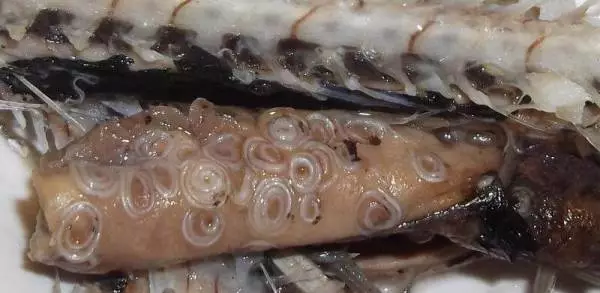

The impact of positive temperatures on helminths
If the ambient temperature is more than 30 degrees Celsius, the worms also die. How quickly this happens depends on the type of helminth that is in the soil.
So, whipworms cannot survive at high temperatures if they are without oxygen for a long time. The usual first dead parasites in the soil can be detected 20 days after exposure to high temperatures.
- At home, ascaris is killed by exposing infected meat or fish to a temperature of at least 55 degrees. In this case, the worms die a few minutes after heat treatment. Similarly, soft toys and things that are dipped in boiling water are disinfected. Larvae and eggs are killed within a few seconds. However, it is important to take into account that the water temperature is at least 70 degrees.
- Also, parasites can die at a temperature of 25 degrees, but only if the soil moisture level is 10 percent. At the same time, the survival conditions for different types of helminths may differ.
- Pinworm eggs lose their viability when exposed to temperatures of 40 degrees. The death of parasites occurs on the third day after heat treatment. In this case, it is necessary to ensure that the humidity of the environment is no more than 60 percent.
Symptoms of worm infestation
Abdominal pain and gastrointestinal upset are the main symptoms of infection.
Worm infestation has no specific symptoms. The larvae of parasites in the body provoke processes that are very similar to many diseases. This makes it difficult to make a diagnosis, especially in cases where external manifestations have arisen long after eating the food that caused the infection. Most often, infection is indicated by:
- heat;
- gastrointestinal disorders (diarrhea, nausea, vomiting, pain in the abdomen and right hypochondrium);
- skin rashes;
- headache, fatigue, apathy, loss of appetite.
Some parasites may not manifest themselves in any way. Therefore, causeless anemia (when a person eats properly, leads a healthy lifestyle and is not exhausted by hard physical work) is the first signal for a visit to an infectious disease specialist. Untimely identified parasites can be fatal.
Types of worms that are SAFE for humans
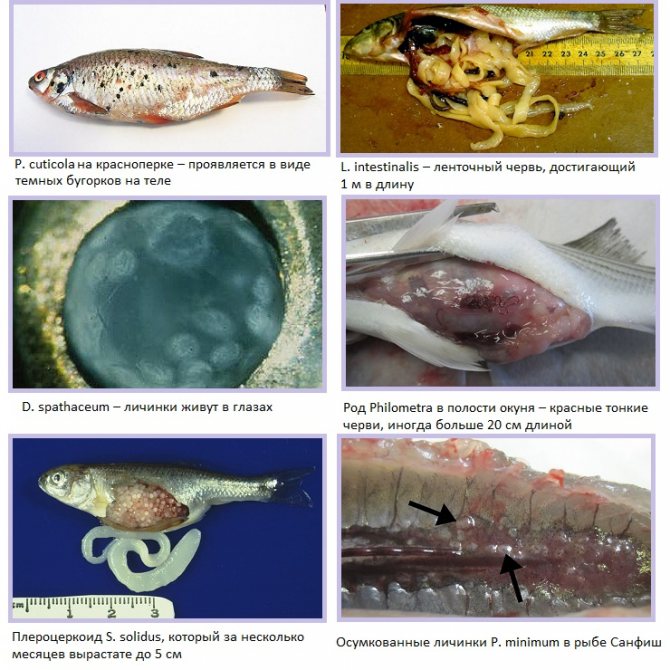

Posthodiplostomum cuticola is a representative of the Diplostomatidae family from the Trematoda class, which causes the disease in fish - postodiplostomosis. Infection with this helminth appears as black dots throughout the body of the fish. Most often it parasitizes in the body of carp, perch, roach and other freshwater fish. With a strong infection with Posthodiplostomum cuticola, the fish loses its presentation.
Diplostomum spathaceum is a helminth that also belongs to the Diplostomatidae family. Its larvae, entering the body of fish, are localized in the lenses of the eyes, causing them to become cloudy. For humans, this type of parasite is not dangerous, and growth retardation and blindness are observed in infected fish. Most often, Diplostomum spathaceum is found in silver carp, trout, etc.
Philometra fasciati, Philometra lethrini and other representatives of this genus are red worms related to nematodes, about 10 cm long. They most often affect cyprinids, localized in scale pockets (females) or the shell of the swim bladder (males). After removing helminths by cleaning, the fish is suitable for consumption (with mandatory heat treatment).
Ligula intestinalis (common ligula or ligula) is a tapeworm that infects fish. In their body, he, like the broad tapeworm, resides in the form of a plerocercoid (the last larval form), but at the same time reaches a much larger size. In length, it can grow up to one meter and, with such dimensions, exert strong pressure on organs, causing serious harm. For humans, he does not pose a danger, and his ultimate goal is to get into a fish-eating bird, where he quickly matures, produces eggs and soon dies. A bird that swallows such a worm as a result spreads eggs along with feces, but does not suffer itself.
Schistocephalus solidus is another tapeworm among fish parasites. life cycle is similar to the previous parasite. But this helminth does not reach such an impressive size (the length of the larva is several centimeters), it has a wider shape and parasitizes in small fish (stickleback). It is not dangerous for humans, since the final owners are birds.
Posthodiplostomum minimum is a widespread trematode species, especially in North America and Mexico. Larvae in the last stage (metacercariae) live in fish and are visible, if you look closely, with the naked eye. The life cycle is not fully understood, but it is known that birds and even some reptiles can become infected and become the final owners.
Ligulosis
Ligulosis. The causative agent is immature forms of belt worms up to 120 cm long.
Sexually mature individuals live in the intestines of fish-eating birds: gulls, grebes, cormorants, herons. These are the so-called final masters. In addition to them, 2 intermediate hosts are involved in the development of the beetles - cyclops and fish, mainly carp (bream, silver bream, roach, rudd, roach).
The caught fish, affected by the thongs, after removing them from the abdominal cavity, although suitable for food, is less nutritious and tasty.
Is it possible to eat fish with worms
Having found worms during cutting, you should not always rush to get rid of a valuable product. You can eat fish with worms after thorough heat treatment. Under the influence of temperatures below 25 ° C and more than 100 ° C, parasites are completely killed, and the product becomes suitable for consumption.
What if I ate fish with worms?
If, nevertheless, raw or insufficiently processed fish infected with parasites have been eaten, it is worth contacting a doctor. Upon confirmation of helminthic invasion after the delivery of tests, the survey carried out, appropriate therapeutic measures are taken.
Precautions: correct handling
Considering that almost all river fish are infected with helminthiasis, a person can protect himself from this disease only by strictly observing the rules for its preparation:
- You need to cook the fish for at least 20 minutes from the moment the water boils. A large carcass should be cut into pieces. Frying each side is carried out for 10 minutes.
- Salting is done in portions of 2 kg. The safest fish is kept in the cold for 20 days in a strong saline solution.
- Worms in frozen fish are completely destroyed. In the freezer, freezing it in order to prevent worms should be carried out for at least two weeks.
Parasitic diseases pose a serious threat. Nevertheless, you should not give up a tasty and healthy product, knowing how not to get infected with worms from fish.
Parasites in fish are dangerous organisms that can severely compromise human health. According to statistics, 75% of the total world catch contains eggs of parasites, it is often impossible to see them with unarmed gas and it is possible to determine that the fish is infected only with the help of a microscope. Nevertheless, fish is a very valuable and useful product for the human body, therefore, you should not refuse to eat it, especially since not all helminths in fish are dangerous for people. In addition, with proper preparation, you can protect yourself and your loved ones from negative consequences.
It is important to know fish worms - how they look (if it is possible to make out them), at what temperature parasites die in fish, how to properly prepare a product in order to prevent pests from entering the human body
Prevention measures for helminthic invasion
It is especially necessary to boil underwear and bedding when there is an infected adult or child in the house. After washing, the linen must be ironed with an iron.


Regular cleaning of the house reduces the risk of contracting certain diseases. Especially if there are children in the house
Children's toys and household items should be treated with detergent. In winter, carpets and soft toys are taken outside and kept in the cold for at least an hour. It is mandatory to carry out daily wet cleaning using detergents.
Each person is free to decide for himself which path to choose: to prevent infection or to be treated for worms. Medicines against parasites have a toxic effect on the internal organs of a person, which can lead to the development of serious complications. No matter how difficult the prevention of helminthic invasions may seem, this method is much cheaper and safer.
Fish is a favorite food of many people all over the world. The variety of types and tastes makes it an irreplaceable source of nutrients, requires certain skills in cutting and cooking. But often fish is a source of parasite infestation.
Some of them are harmless to humans, but many are dangerous to humans and can cause significant harm to health.
It is not always possible to recognize an infected fish - this is determined by the type of helminth, the environment from which the fish is caught, the skills of the fishermen and the observance of sanitary standards.
In order to kill parasites in fish, it undergoes sanitary examination and processing on fishing vessels and fish processing enterprises, but it is still worth knowing about the danger that it contains, because the place where it was brought from is not always known for sure.
Cat fluke
Opisthorchiasis in fish is one of the most severe helminthic infestations, which is most often caused by the feline or Siberian fluke, which is most often found in the representatives of the cyprinid family. This parasite is able to live in the gallbladder, its ducts and the human liver. It is quite difficult to remove and detect this helminth.
Infection occurs when eating poorly salted, boiled or fried fish. The development of the helminth in the body of the final host lasts for several months, after which it turns into a sexually mature individual and begins to lay.In the acute course of opisthorchiasis, symptoms such as high fever, fever, allergic rashes, stool disorders, nausea and vomiting are observed. An adult feline fluke that has gone through a developmental cycle is called a hepatic fluke.
The symptomatology of the disease is in many ways similar to opisthorchiasis and often becomes chronic. With a long course of the disease, a person may experience complications such as liver abscess, acute pancreatitis, cholangitis, gallstone pathology, etc.
Precautions
To prevent the likelihood of this disease, you must follow several rules and guidelines.
Avoid the need to eat fish raw, and this applies to freshwater and marine species. It is also necessary to limit the consumption of seafood and always adhere to thorough heat treatment.
If a white worm is found in a fish or other helminth, it is necessary to determine its type and the degree of potential danger.
Usually, if an individual has passed the stage of infection, it has an unattractive appearance, as well as a weak muscle structure, clicking on which, you will notice a fossa.
The eyes are "transparent" and the body and internal organs drain the foul odor.
It is necessary to take out all the insides, without exception, and thoroughly rinse the fish under a stream of running water, this will wash off the bacteria and avoid general poisoning of the body with fish meat.

